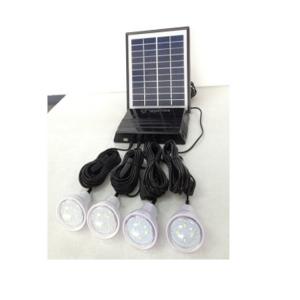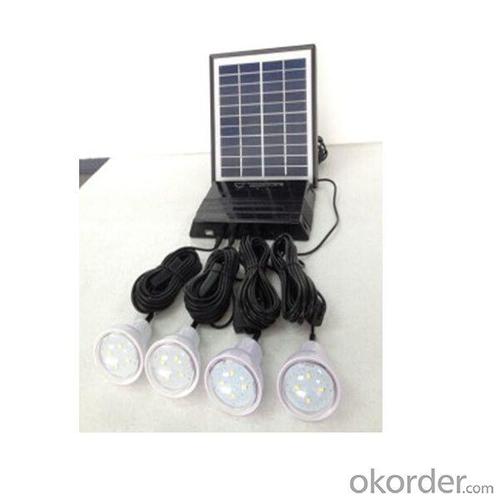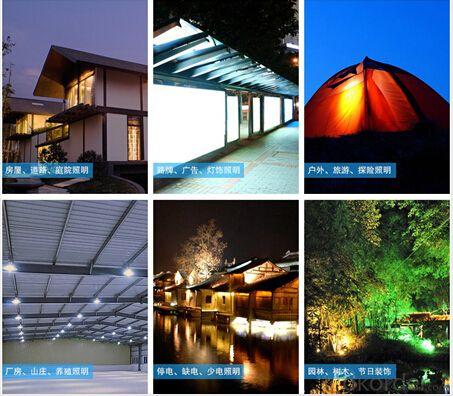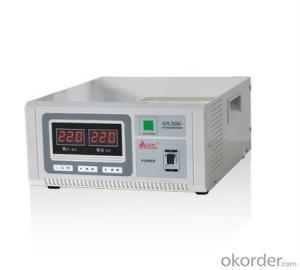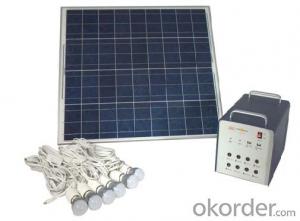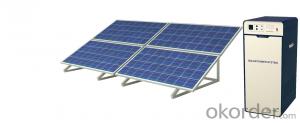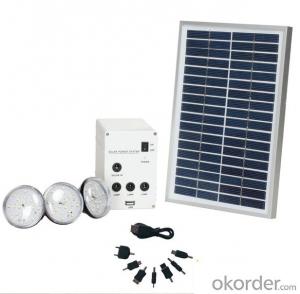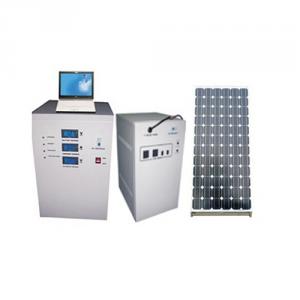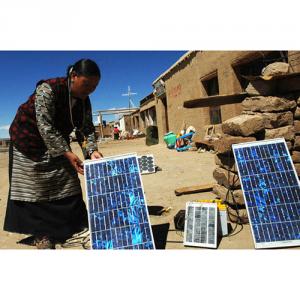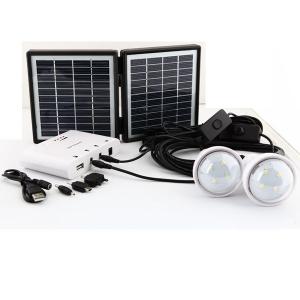Solar Energy Systems Whitehaven 4w 10w 20w 50w 80w 100w Solar Lighting System with Mobile Charge 4 LED Bulbs 4000mAh Li-ion Battery Black CE ROHS
- Loading Port:
- Shenzhen
- Payment Terms:
- TT/LC
- Min Order Qty:
- 100Sets set
- Supply Capability:
- 20000 SETS Per Month set/month
OKorder Service Pledge
OKorder Financial Service
You Might Also Like
This 4w solar lighting system with mobile charge for iphone 4w solar panel 4400mah lithium batetry black ce rohs is a portable solar energy system , solar energy generator can generate power for 4 LED bulbs, it can work 6 hours every day.
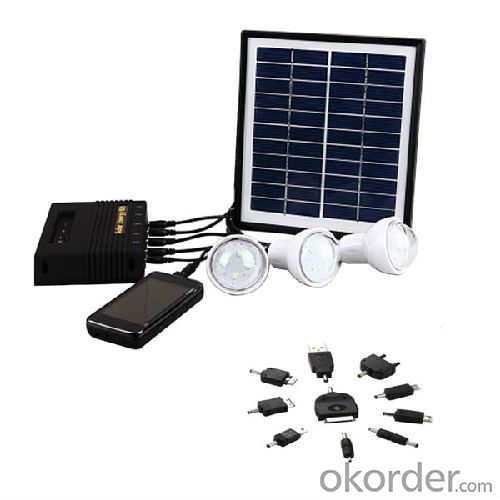
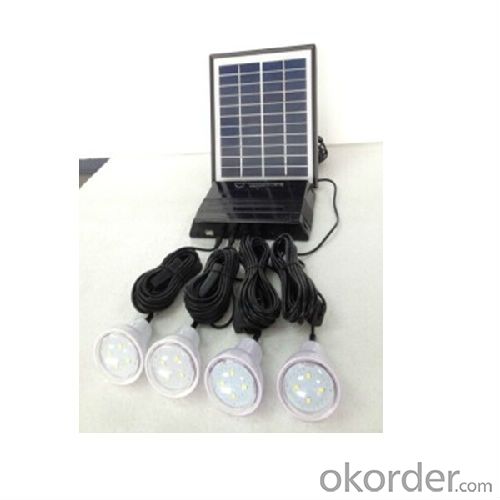
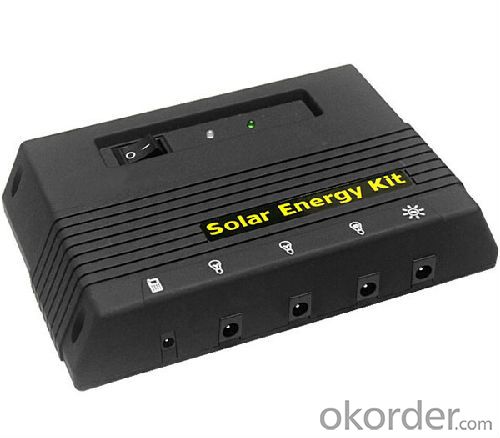
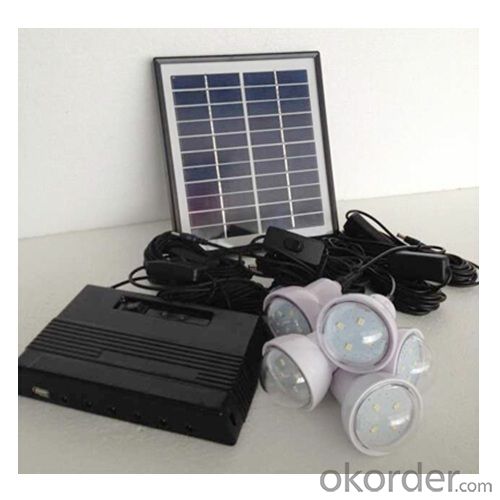
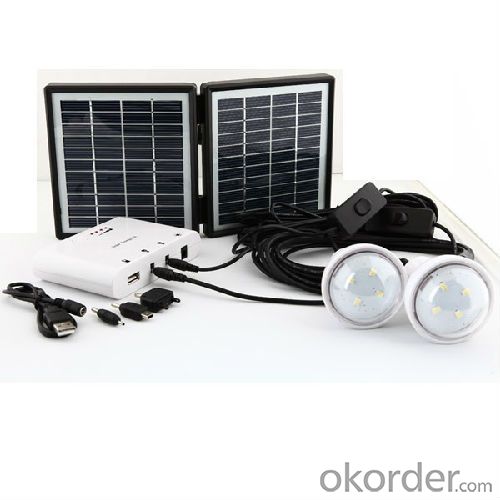
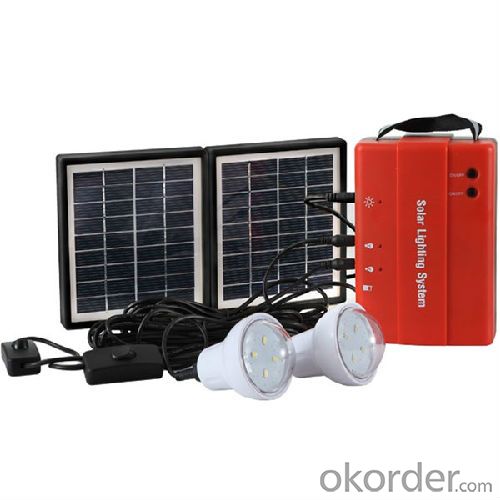
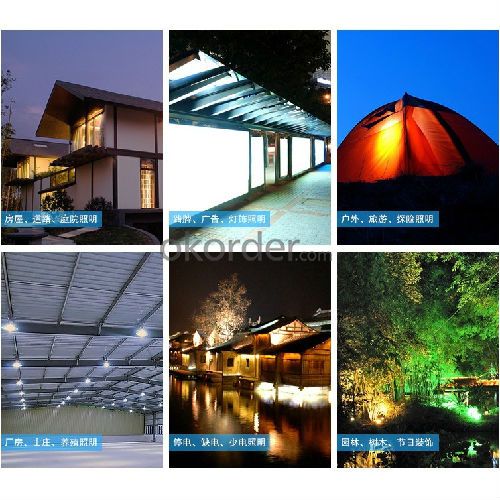
Feature
| battery: 7.4V 4400mAh Lithium battery |
| solar panel: 4W 11V Solar Panel with 5M cable |
| led bulbs: 0.9W LED bulb with 4pcs |
| LED bulb: each with 5M cable and switch on cable, IP54. |
| With LED charging indicator: yes |
| Mobile phone charging: USB port 5V 1000mA output, with 5-in-1 USB mobile charging cable (Nokia 6101,Sumsung G600, Micro USB, Mini USB,Iphone 4/4S) |
| Overcharge and overdischarge protection: yes |
| Rechargeable by AC charger: optional |
| Working hours on full battery: |
| 5 bulbs-6 hours |
| 4 bulbs-7.5 hours |
| 3 bulbs-10 hours |
| 2 bulbs-15 hours |
| 1 bulb-30 hours |
| Full charging time |
| By solar-16 hours (under direct sunshine) |
| By AC charger-about 11 hours |
Usage/Applications
Rural homes, campers, fishermen, outdoor campaigns or activities, etc. Remote area, mountainous area, desert area, grassland area,
Village, country area, Camping, outdoor activities, travel, Lighting at night.
Customized options
1. OEM/ODM available;
2. It's also available to customize your own solar lighting systems, solar lanterns, or any solar lighitng products by giving us solar lights picture / 3D draft / technical datas.
Packing & Delivery
Package:
1* solar panel
1* portable system box
4* LED bulbs with on/off button on cable
inner box size: 335*255*84mm
10pcs/carton
carton size:525*350*450mm
Delivery:
|
Shipping Service |
Estimated Delivery Time |
|
DHL |
2-8 business days |
|
FedEx |
3-8 business days |
|
TNT |
2-10 business days |
|
UPS |
1-7 business days |
|
EMS |
6-14 business days |
|
ePacket |
7-12 business days |
|
China Post Air Mail |
7-15 business days |
|
China Post SAL |
14-30 business days |
|
Air freight |
3-10 business days |
|
By Sea |
30-40 business days |
1. 3-5 business days for Sample Orders; 7-30 business days for Bulk Orders for Bulk Orders.
2. "Business days" means Monday-Friday, excluding holidays.
3. DHL and UPS cannot ship to military or P.O. boxes address
4. The Shipping Service above is for reference only, for any other questions, please feel free to contact us.
Factory
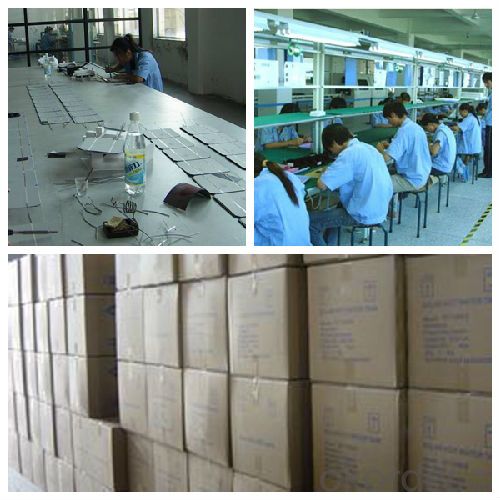
- Q: Can solar energy systems be used for space cooling?
- Yes, solar energy systems can be used for space cooling. Solar-powered air conditioning systems, also known as solar coolers, utilize the sun's energy to generate electricity, which powers the cooling process. These systems typically incorporate solar panels to convert sunlight into electricity and use it to run the compressor, fan, and other components necessary for cooling. By harnessing renewable energy, solar cooling offers an environmentally friendly and sustainable solution for cooling spaces.
- Q: Can solar energy systems be used in powering outdoor signage or billboards?
- Yes, solar energy systems can be used to power outdoor signage or billboards. Solar panels can be installed on the roof or nearby structures to harness sunlight and convert it into electricity. This electricity can then be used to power the lights or digital displays of the signage or billboards, making them completely independent of the traditional power grid. Solar energy systems are particularly suitable for outdoor signage as they are often located in areas with abundant sunlight. Additionally, using solar energy helps reduce the carbon footprint associated with traditional electricity generation, making it an environmentally friendly choice.
- Q: How do solar energy systems affect the electrical grid?
- Solar energy systems can have both positive and negative impacts on the electrical grid. On the positive side, solar energy systems can reduce the demand for electricity from the grid during sunny hours when they are producing energy. This can alleviate stress on the grid and reduce the reliance on fossil fuel-based power plants. Additionally, excess energy generated by solar systems can be exported back to the grid, increasing the overall supply of renewable energy. However, the intermittent nature of solar power can also pose challenges to the electrical grid. Fluctuations in solar energy production can create imbalances in supply and demand, requiring grid operators to manage and balance the system more dynamically. This may necessitate grid upgrades and the development of energy storage solutions to ensure grid stability and reliability.
- Q: Can solar energy systems be used for powering electric bus charging stations?
- Solar energy systems have the capability to be utilized in the operation of electric bus charging stations. To harness sunlight and convert it into electricity, solar panels can be situated on the rooftops of the charging stations or in close proximity. The resulting electricity can subsequently be employed to charge the batteries of electric buses. Solar panels generate clean, renewable, and sustainable energy, which renders them a perfect option for powering electric bus charging stations. Moreover, the utilization of solar energy diminishes reliance on fossil fuels and aids in the mitigation of greenhouse gas emissions, thus presenting an environmentally conscious solution.
- Q: Can a solar energy system be installed on a library or educational institution?
- Indeed, the installation of a solar energy system on libraries and educational institutions is possible. This approach has gained popularity among many of these establishments as an effective and eco-friendly solution to their energy requirements. By adopting solar energy, libraries and educational institutions not only cut down on electricity costs but also demonstrate their dedication to clean energy and environmental consciousness. Libraries and educational institutions often boast expansive rooftops or available open spaces that make them perfect candidates for solar panel installation. These panels can be affixed to the roof or positioned on the ground, depending on the space available and structural considerations. Moreover, solar panels can even be incorporated into building materials like windows or walls, offering aesthetically pleasing and innovative installations. By embracing solar energy, libraries and educational institutions can generate their own electricity and reduce their dependence on fossil fuels. This approach can lead to substantial long-term savings since solar energy is a renewable resource that does not require ongoing fuel expenses. Additionally, any excess electricity produced by the solar panels can be fed back into the grid, enabling libraries and educational institutions to contribute to the local energy supply and potentially receive incentives or credits from the government. Furthermore, the installation of solar panels on libraries and educational institutions can serve as a valuable educational tool. It creates an opportunity to educate students, staff, and the community about the advantages of renewable energy, energy preservation, and environmental stewardship. Schools and libraries can incorporate the solar energy system into their curriculum, offering a hands-on learning experience and engaging students in comprehending the scientific, technological, and environmental aspects of solar energy. In conclusion, libraries and educational institutions can benefit from the installation of a solar energy system, offering advantages such as cost savings, environmental sustainability, and educational opportunities. The decision to opt for solar energy aligns with the values held by these establishments and showcases their commitment to a cleaner, more sustainable future.
- Q: Can solar energy systems be used in areas with limited water resources?
- Yes, solar energy systems can be used in areas with limited water resources. Unlike other forms of energy generation such as fossil fuels or nuclear power, solar energy systems do not require significant amounts of water for their operation. Solar panels convert sunlight directly into electricity without the need for water cooling or steam generation, making them suitable for use in arid regions or areas facing water scarcity. This makes solar energy a sustainable and viable solution for electricity production in areas with limited water resources.
- Q: Can solar energy systems be used in commercial buildings?
- Yes, solar energy systems can definitely be used in commercial buildings. In fact, they are increasingly being adopted by businesses worldwide as a sustainable and cost-effective solution for meeting their energy needs. Solar panels can be installed on the rooftops or facades of commercial buildings, harnessing the power of the sun to generate electricity. This clean and renewable energy source not only helps reduce greenhouse gas emissions but also provides long-term energy savings for businesses.
- Q: What is the role of charge controllers in solar energy systems?
- The role of charge controllers in solar energy systems is to regulate and control the flow of electricity between the solar panels and the batteries. They ensure that the batteries are charged efficiently and prevent overcharging or damage to the batteries. Additionally, charge controllers help optimize the performance and lifespan of the batteries by providing protection against over-discharging and excessive voltage.
- Q: Can solar energy systems be used in powering concert halls or auditoriums?
- Certainly, concert halls and auditoriums can make use of solar energy systems to generate power. The popularity of utilizing solar energy in large venues like these has been increasing due to its various advantages. The installation of solar panels on the roof or surrounding areas of the venue allows for the capture of sunlight and its conversion into electricity. This renewable energy source can then be used to power all the electrical equipment and lighting systems within the concert hall or auditorium. One of the main benefits of incorporating solar energy systems in these venues is the potential for cost savings. Concert halls and auditoriums typically consume substantial amounts of electricity, especially during events and performances. By harnessing solar power, these venues can significantly reduce their dependence on the traditional power grid and consequently lower their energy bills. Furthermore, solar energy systems require minimal maintenance once they are installed, which further contributes to their long-term cost-effectiveness. Furthermore, the integration of solar energy into concert halls and auditoriums aligns with the global emphasis on sustainability and the reduction of carbon footprints. By utilizing renewable energy sources such as solar power, these venues can considerably decrease their greenhouse gas emissions and promote a more environmentally friendly approach to energy consumption. This not only benefits the venue itself but also contributes to the overall sustainability goals of the local community and society as a whole. However, it is important to take into account that the size and power requirements of concert halls and auditoriums may necessitate a significant investment in solar panels and related equipment. Factors such as the venue's energy demand, available installation space, and the local climate all need to be assessed during the planning stage. Ensuring that the solar energy system is appropriately sized to meet the energy needs of the venue and designed to withstand the specific weather conditions of the location is crucial. In conclusion, it is indeed possible to use solar energy systems to power concert halls or auditoriums. The advantages of employing solar power in these venues encompass cost savings, environmental sustainability, and a reduction in reliance on the traditional power grid. With careful planning and installation, solar energy can provide a reliable and efficient source of electricity to meet the energy demands of such large-scale venues.
- Q: What is the impact of hail on solar panels?
- Hail can have a detrimental impact on solar panels, as the forceful impact of hailstones can cause physical damage to the panels. This damage can result in cracks or fractures in the glass or photovoltaic cells, reducing the efficiency and effectiveness of the panels. Furthermore, hail can also impair the electrical connections within the solar panel system, leading to malfunction or complete failure. Therefore, it is important to consider protective measures, such as installing hail guards or utilizing insurance policies, to mitigate the potential damage caused by hail on solar panels.
1. Manufacturer Overview
| Location | |
| Year Established | |
| Annual Output Value | |
| Main Markets | |
| Company Certifications |
2. Manufacturer Certificates
| a) Certification Name | |
| Range | |
| Reference | |
| Validity Period |
3. Manufacturer Capability
| a) Trade Capacity | |
| Nearest Port | |
| Export Percentage | |
| No.of Employees in Trade Department | |
| Language Spoken: | |
| b) Factory Information | |
| Factory Size: | |
| No. of Production Lines | |
| Contract Manufacturing | |
| Product Price Range | |
Send your message to us
Solar Energy Systems Whitehaven 4w 10w 20w 50w 80w 100w Solar Lighting System with Mobile Charge 4 LED Bulbs 4000mAh Li-ion Battery Black CE ROHS
- Loading Port:
- Shenzhen
- Payment Terms:
- TT/LC
- Min Order Qty:
- 100Sets set
- Supply Capability:
- 20000 SETS Per Month set/month
OKorder Service Pledge
OKorder Financial Service
Similar products
Hot products
Hot Searches
Related keywords
